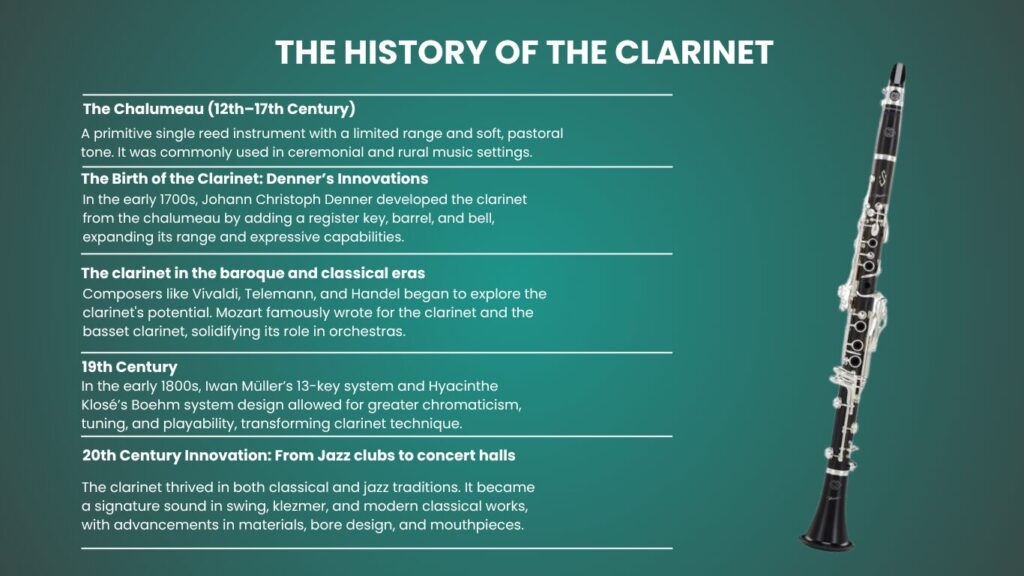Clarinet history and development… 🎶
The clarinet is one of the most versatile and expressive instruments in the woodwind family, known for its warm, dynamic tone and wide range. Its evolution spans over a millennium, beginning with a much simpler ancestor: the chalumeau. Used in Europe from the 12th to the 17th centuries, the chalumeau was a primitive single-reed instrument with eight tone holes and no register key. Its range was limited to about an octave and a half, and its soft, reedy sound was especially valued in pastoral and ceremonial settings.
The birth of the clarinet: Denner’s innovations
Around the turn of the 18th century, a German instrument maker named Johann Christoph Denner, based in Nuremberg, made crucial modifications to the chalumeau. He added a barrel and bell, and most importantly, introduced a register key that allowed the instrument to overblow at the interval of a twelfth rather than an octave. This innovation dramatically extended the instrument’s range and paved the way for the modern clarinet. Some historians believe his son, Jacob Denner, may have further developed the design by adding a key to extend the lower register. The new instrument was initially met with curiosity, and its role in ensembles was limited in the early decades.
The clarinet gradually found a place in the Baroque orchestra, with composers such as Vivaldi, Telemann, and Handel incorporating it into their works. However, it wasn’t until the Classical period that the clarinet began to flourish. Mozart, in particular, had a deep appreciation for the instrument. His compositions for clarinet, including the famous Clarinet Quintet in A Major (K.581) and the Clarinet Concerto in A Major (K.622), showcased its expressive capabilities and cemented its role as a solo and ensemble instrument. Mozart wrote much of his clarinet music for Anton Stadler, who played a now-obsolete version of the clarinet known as the basset clarinet, which had an extended lower range.
As music evolved and demanded more chromaticism and technical flexibility, so too did the clarinet. The 19th century was a period of rapid innovation. In 1812, Iwan Müller introduced a new design featuring air-tight pads made of leather and a 13-key mechanism that allowed for fully chromatic playing. This was a major breakthrough, as earlier clarinets had struggled with keywork limitations that made certain notes difficult to play or tune accurately. Müller’s instrument, sometimes called the “clarinette omnitonique,” laid the groundwork for further developments.
The most influential advancement came in the 1830s and 1840s with the collaboration between Hyacinthe Klosé and Louis-Auguste Buffet. Drawing inspiration from Theobald Boehm’s work on the flute, they developed the Boehm system clarinet. This system introduced ring keys and a refined mechanism that allowed for smoother finger transitions, improved tuning, and greater consistency across the instrument’s range. Patented in 1843, the Boehm system became the standard for most clarinetists worldwide, particularly in Western Europe and the Americas.
However, not all regions adopted the Boehm system. In Germany and Austria, the clarinet continued to evolve along a different path. Oskar Oehler, building on Müller’s design, developed a more complex system with up to 27 keys. This German system, known as the Oehler system, provided a darker, more focused tone and remains the preferred choice in many Germanic orchestras to this day. The tonal differences between Boehm and Oehler clarinets are significant and have influenced performance practices and sound preferences across musical cultures.
20th Century innovation: From jazz clubs to concert halls
Throughout the 20th century, clarinet manufacturing continued to improve. Companies like Selmer produced several landmark models, such as the Centered Tone and the Series 9, which were favored by jazz legends like Benny Goodman and classical performers alike. Developments in mouthpiece design, reed production, and bore construction further enhanced the instrument’s playability and tonal variety. Hybrid models such as the Reform-Boehm system attempted to bridge the gap between Boehm ergonomics and German tonal ideals.
The modern clarinet family is extensive and includes a range of instruments, each with its own timbral characteristics. From the high-pitched E-flat clarinet to the deep contrabass clarinet, these instruments cover a wide pitch spectrum and are used in orchestral, chamber, and solo settings. Their roles have expanded beyond classical music into jazz, klezmer, folk, and contemporary experimental genres.
The modern clarinet family
Today’s clarinet family includes a range of instruments across the pitch spectrum:
- E-flat clarinet (high and bright)
- B-flat clarinet (standard orchestral and band instrument)
- A clarinet (favored in classical repertoire)
- Bass clarinet
- Contrabass clarinet
- And the Travel Clarinet… 🙂
These instruments are used in classical music, jazz, klezmer, folk traditions, and contemporary experimental music. The clarinet’s role continues to grow, supported by innovations in digital acoustics and design.
Understanding the clarinet’s historical evolution not only provides valuable context for performers but also connects them to a rich tradition of craftsmanship, cultural exchange, and musical innovation. Each development, from Denner’s first register key to today’s digital acoustical modeling, reflects the clarinet’s adaptability and enduring appeal.


Explore more content!







Happy reading!
Odisei Music Team
